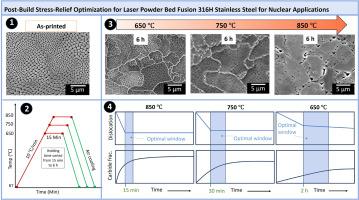Post-build stress-relief optimization for laser powder bed fusion 316H stainless steel
IF 2.9
Q2 MATERIALS SCIENCE, MULTIDISCIPLINARY
引用次数: 0
Abstract
Nuclear energy remains a critical component of a diversified and efficient energy portfolio, offering reliable, high-capacity, and low-carbon power. However, in the U.S., aging infrastructure and the slow qualification and deployment of advanced materials and manufacturing techniques hinder progress in next-generation reactor technologies. This study explores the application of laser powder bed fusion (LPBF) additive manufacturing for stainless steel 316H, with a focus on optimizing post-build heat treatments to enhance material properties for high-temperature nuclear applications. The research targets the optimization of stress-relief temperatures to alleviate postbuild residual stresses, ensuring improvements in the microstructural corelated properties. A series of microstructural and mechanical evaluations were performed on LPBF-printed SS-316H samples which were subjected to annealing at temperatures varying between 650 °C and 850 °C. X-ray diffraction, scanning electron microscopy, and transmission electron microscopy analyses revealed that increasing the heattreatment temperature accelerated dislocation recovery. Vickers microhardness measurements showed an initial reduction in values, followed by stabilization over extended durations at all the temperatures. While higher temperatures facilitated faster recovery, they also promoted carbide precipitation along grain and solidification cell boundaries, narrowing the safe processing window. In contrast, heat treatment at 650°C preserved the cellular substructure and enabled controlled carbide precipitation over time. These findings highlight the importance of time–temperature optimization and suggest that 650°C for up to 2 h provides the most favorable balance between recovery and carbide control for a stress-relief treatment.

激光粉末床熔合316H不锈钢的后期应力消除优化
核能仍然是多元化和高效能源组合的重要组成部分,提供可靠、高容量和低碳的电力。然而,在美国,老化的基础设施以及先进材料和制造技术的鉴定和部署缓慢阻碍了下一代反应堆技术的进步。本研究探索了激光粉末床熔合(LPBF)增材制造在不锈钢316H上的应用,重点是优化后期热处理,以提高材料在高温核应用中的性能。该研究的目标是优化应力消除温度,以减轻构建后的残余应力,确保改善微观结构相关性能。对lpbf打印的SS-316H样品进行了一系列的显微组织和力学评价,并在650°C和850°C之间进行了退火。x射线衍射、扫描电镜和透射电镜分析表明,热处理温度的升高加速了位错的恢复。维氏显微硬度测量显示初始值降低,随后在所有温度下的长时间稳定。虽然较高的温度有助于更快的恢复,但它们也促进了沿晶粒和凝固细胞边界的碳化物析出,从而缩小了安全加工窗口。相比之下,650°C的热处理保留了细胞亚结构,并随着时间的推移控制了碳化物的析出。这些发现强调了时间-温度优化的重要性,并表明650°C长达2小时可以在恢复和碳化物控制之间提供最有利的平衡,以进行应力消除处理。
本文章由计算机程序翻译,如有差异,请以英文原文为准。
求助全文
约1分钟内获得全文
求助全文
来源期刊

Materialia
MATERIALS SCIENCE, MULTIDISCIPLINARY-
CiteScore
6.40
自引率
2.90%
发文量
345
审稿时长
36 days
期刊介绍:
Materialia is a multidisciplinary journal of materials science and engineering that publishes original peer-reviewed research articles. Articles in Materialia advance the understanding of the relationship between processing, structure, property, and function of materials.
Materialia publishes full-length research articles, review articles, and letters (short communications). In addition to receiving direct submissions, Materialia also accepts transfers from Acta Materialia, Inc. partner journals. Materialia offers authors the choice to publish on an open access model (with author fee), or on a subscription model (with no author fee).
 求助内容:
求助内容: 应助结果提醒方式:
应助结果提醒方式:


